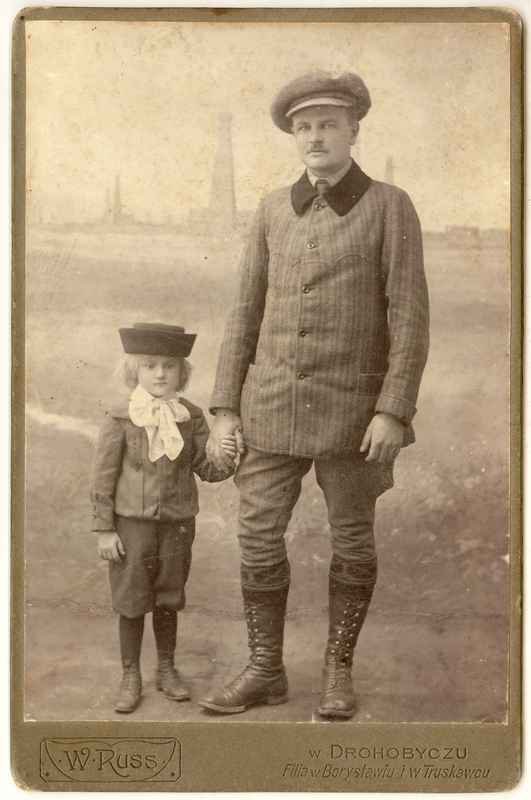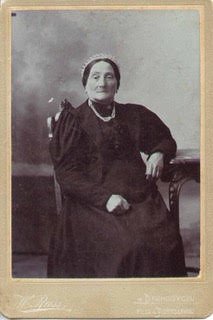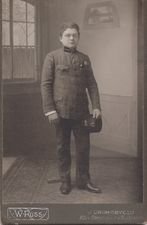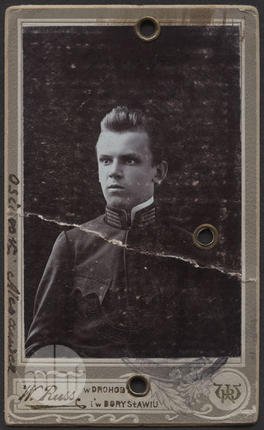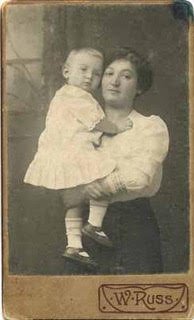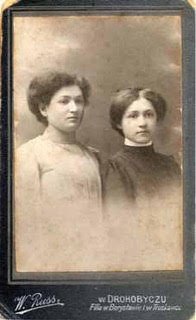Wilhelm (Mechel Wolf) Russ (1875–1935) Pioneer of Polish Photography
1st cousin 3x removed
I found Wilhelm Russ by accident - whilst searching for patronymic family names, I came across him under his Jewish name of Mechel Wolf, a name I knew was carried down in the Rothenberg family.
Wilhelm or Mechel Wolf Russ, was born in 1875 in Drohobycz, Galicia (then part of the Austro-Hungarian Empire), to Hersz (Hersch) Russ and Rachla Rothenberg. Rachla was the twin sister of my 2x great grandfather Sindel. Both of his parents were born in 1840 and belonged to long-standing Jewish families from the region. Through his mother Rachla, Wilhelm was connected to the Rothenberg lineage, a Jewish family with rabbinical and merchant roots in Skole, Drohobycz, and Stryj.
Wilhelm's maternal grandfather, Aaron Hersch Rothenberg served as a forest warden in Drohobycz and was the son of the rabbi Samuel Leib Rothenberg and Ester (possibly Knarienstein). Rachla's twin brother, Sindel Rothenberg, and his descendants played active roles in Jewish communal life in Galicia. This lineage deeply rooted Wilhelm in a rich tradition of Jewish intellectual and economic life, which would later inform his work documenting Jewish and industrial life in Galicia through photography.
In 1911, Wilhelm married Chana (Anna) Fleischer in Borysław, a rapidly developing oil town in the Drohobycz district. They had three children:
Maksymilian Milek Russ, born 21 April 1912 in Borysław
Moshe Meir (Gustaw) Russ, born 14 December 1914 in Vienna
A daughter, born and died on 17 October 1918 in Borysław
As World War I broke out in 1914, Russian forces rapidly advanced into Galicia, prompting mass civilian evacuations. Like many Galician Jews, Wilhelm Mechel Russ fled with his family to safer parts of the Austro-Hungarian Empire - settling in Vienna, the imperial capital. It was during this time, on 14 December 1914, that Wilhelm’s second son, Moshe Meir (Gustaw) Russ, was born in the city.
Vienna became a critical refuge for thousands of displaced Jews from Eastern Galicia. The city was a melting pot of cultures and ideologies, with a vibrant Jewish intellectual and artistic life. Though Wilhelm was primarily known for his photographic work in Galicia, his time in Vienna likely exposed him to new styles, technologies, and a broader network of professionals in photography and publishing. It is known he delved into microphotography whilst here, documenting WWI’s destruction and adding to his reputation as a pioneer.
After the armistice in 1918 and the collapse of the Austro-Hungarian Empire, the Russ family returned to Borysław, now part of the Second Polish Republic. Tragically, their newborn daughter died that same year, suggesting that the postwar return was marked by both hope and sorrow.
Wilhelm’s career spanned the turn of the 20th century to the interwar period. He established his first photographic studio around 1900, initially on ul. Samborska in Drohobycz and later in the city center on ul. Mickiewicza. He expanded his business by opening branches in Borysław and Truskawiec, becoming one of the most prominent visual chroniclers of Jewish and industrial life in Eastern Galicia.
He worked extensively in Borysław, near Drohobycz, and was active during a time of technological transition - from wet plate collodion to gelatin silver and roll film photography. His studio would have been among the earliest in the region, producing cabinet portraits for the growing middle class and documenting Galician Jewish life before its destruction in the Holocaust.
Wilhelm Russ is widely recognized as a founding figure in the development of photography in Poland, and is recognized as the nestor fotografii polskiej (senior figure of Polish photography), Wilhelm became known for his portraits and was among the first Jewish photographers in Galicia to professionalize portraiture and develop a wide clientele, producing carte-de-visite photographs, portraits, landscapes, and ethnographic imagery - notably his documentation of the booming oil and ozokerite fields around Borysław. His panoramic photos captured iconic views: tight clusters of oil rigs, muddy boardwalks, and puddles of oil in Borysław- a region that by 1909 was Europe’s 4th-largest oil producer, showcasing his role in visually chronicling the industrial landscape
Wilhelm’s work is historically significant not only for its aesthetic value and advancing technique, but also for capturing a vanishing world - the synagogues, street life, and personalities of Galicia’s multicultural towns, which were later devastated during the Holocaust. His contribution came during the transition from 19th-century artisanal photography to 20th-century modernist and documentary styles. His photographic legacy is mentioned in multiple Polish-language publications and regional studies.
Wilhelm didn’t live to see or be included in the destruction of his people - he died at the age of sixty, on 22nd Febuary 1935 in Boryslaw before the Nazi invasion of Eastern Poland.
Tragically, seven years later Wilhelm’s wife, Chana Russ was murdered in the Shoah.
Place of death: Boryslaw, Poland, 1942. Her son Moshe Meir (Gustaw) recorded her death on Yad Vashem.
Wilhelm Russ's work remains vital to the visual history of Galician Jews, the oil industry, and everyday life in one of the most economically dynamic regions of prewar Poland. His portraits and landscapes offer rare glimpses into the cultural and industrial worlds that were largely destroyed during the Second World War..
Moshe Meir (Gustaw) Russ (1914–1992)
After surviving the Second World War (including the Holocaust and Nazi occupation of Poland), Gustaw Russ continued the family’s photographic legacy. He remained in Poland, where he became an active documentary and studio photographer in the postwar years. His work was particularly notable in the photographic documentation of postwar reconstruction, portraiture, and official photographs, especially for identification and archival purposes, and contributions to Polish state institutions and archives, particularly in Warsaw. There is evidence suggesting he worked with the Central Jewish Historical Commission or related efforts in preserving the memory of Jewish communities destroyed during the war.
Gustaw was respected within the photographic community in Warsaw. He reportedly maintained contact with prewar networks, surviving friends, and possibly Jewish cultural organizations during the People's Republic of Poland era.
Following WW2, his brother Maksymilian or Milek Russ moved to Israel and co-founded a “Do not forget Borysław” preservation committee but was tragically killed in 1948 during an excursion to Nablus/Schechem
Jerzy Lewczyński, Archeologia Fotografii (Warsaw: Wydawnictwo Literackie, 1979).
This foundational work on Polish photography identifies Wilhelm Russ as an early practitioner in the Drohobycz-Borysław area.
Lwowska Encyklopedia Fotografii (Encyclopedia of Lviv Photographers) lists Russ among pioneer studio photographers
https://viewpoint-east.org/tag/wilhelm-russ/
https://www.shtetlinks.jewishgen.org/Drohobycz/families/wilhelm-russ-family.html
https://kehilalinks.jewishgen.org/drohobycz/shtetls/history-of-boryslaw.html
https://groups.jewishgen.org/g/main/topic/wilhelm_russ_photographer/70335916
